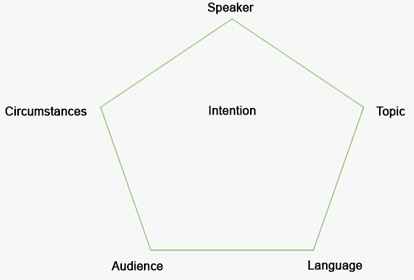The rhetorical pentagram
The rhetorical pentagram is a useful tool for analysis of non-fiction texts.
Consider how each of the elements is linked to all the others:

Text: What genre is it (e.g. article, speech, essay, interview, propaganda)?
Speaker: Who is the sender, what do we know about the sender’s background, status, views etc.?
Circumstances: What kind of communication is used (e.g. written or oral, media: a newspaper (which kind?), a magazine, a radio broadcast, the internet)? What does this mean to the communication between the sender and the audience?
Audience: Who would be likely to be the receivers of the communication (age, sex, education, nationality, etc.)?
Language:
• The structure of the text
• The wording of the introduction and conclusion
• The tone – factual, pompous, humorous, admonitory etc.
• Use of rhetorical devices such as repetition, rhetorical questions, parallels, opposites
• Use of figurative language or connotations
• Use of quotations, intertextuality or references
• Types of arguments – weak or strong?
• Use of logos/ethos/pathos appeal
Topic: What themes are dealt with in the text? Toulmin’s model of argumentation can be used to set up the main argument or message of it. How is the message substantiated? Is the presentation e.g. factual, reliable or emotive?
Intention: Is the overall intention with the text to inform, influence, entertain, educate, convince – or?
